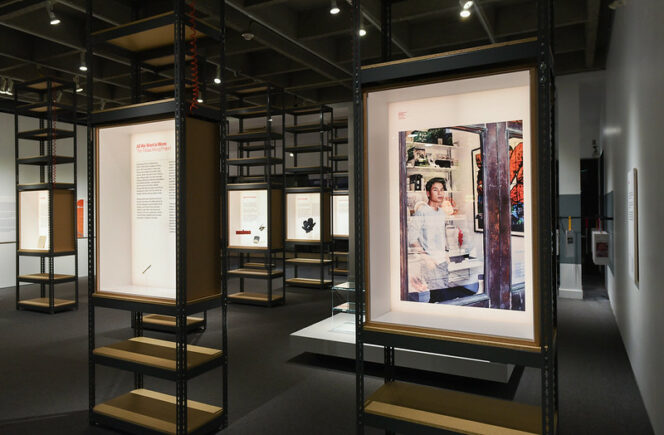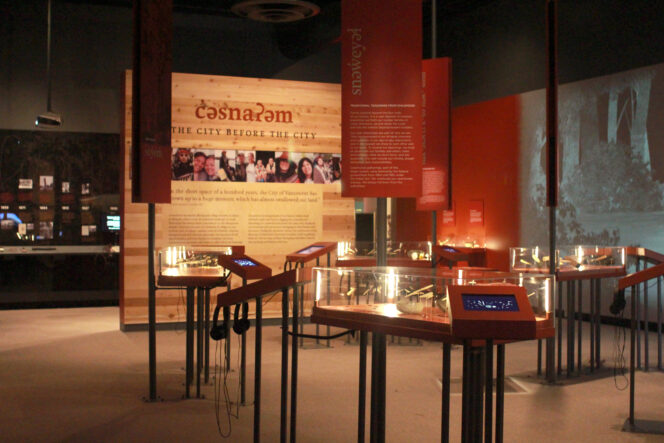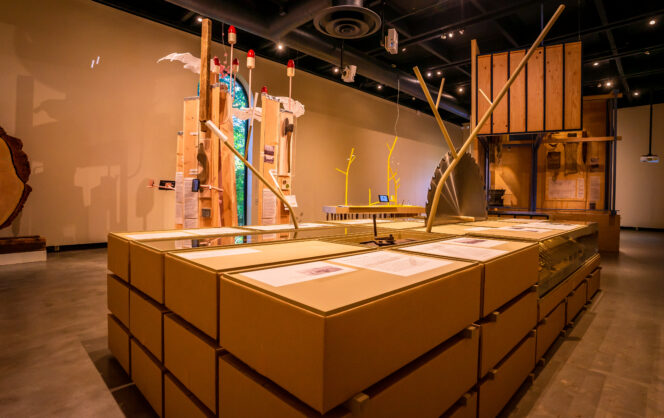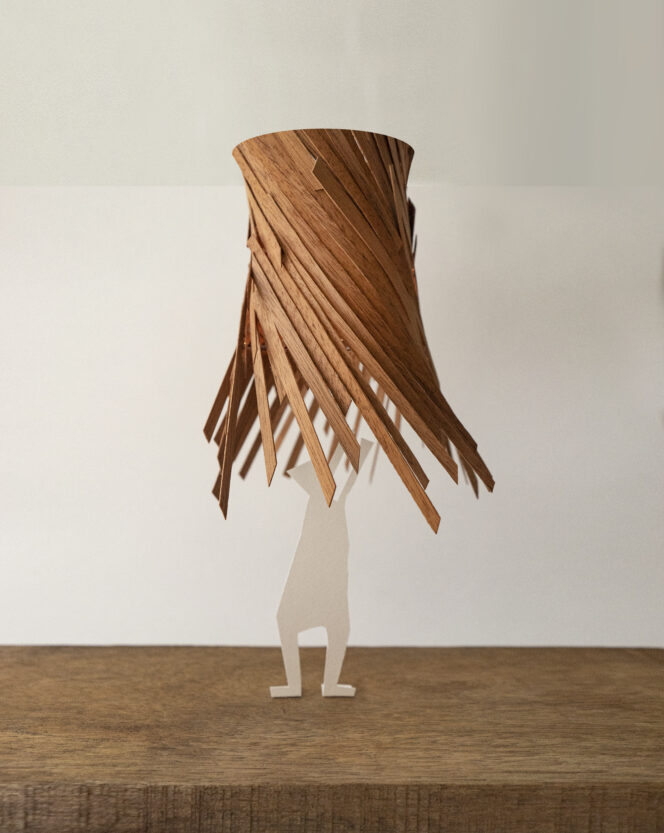Section of the exhibition That Which Sustains Us
Credit: Rebecca Blissett
Originating in 1894, the Museum of Vancouver (MOV) has seen considerable evolution, just as the city it represents has expanded and diversified over time.
The idea for the museum started with the formation of the Art, Historical and Scientific Association, which exhibited pictures and curios, such as a stuffed trumpeter swan, in Alderman Dunn’s building on Granville Street. The exhibition soon shifted to a more permanent location, with donations pouring in from across the country to be housed at the museum.
From our partners:
Viviane Gosselin, Director of Collections and Exhibitions and Curator of Contemporary Culture at MOV, explains that, like many museums, the early City Museum very much was about educating people through the collections that were made up of ‘artefacts’ brought to Vancouver from all around the world. At the time, history and a sense of Vancouver was located and preserved in the Museum.
However, a century later, with multiple location changes and a name change in 2009 to the Museum of Vancouver (MOV), the mandate has shifted considerably. Located on the unceded, ancestral territories of the xʷməθkʷəy̓əm (Musqueam), Sḵwx̱wú7mesh (Squamish), and səlilwətaɬ (Tsleil-Waututh) Nations, in what is presently known as Vanier Park, MOV plays a vital role in helping Vancouverites understand themselves, as well as share who they are to those visiting the city.
Gosselin says that one primary shift has been to new understandings of where stories and history are situated. “All the knowledge is out there and not in the Museum. The Museum becomes a place for facilitating fresh understandings of what Vancouver is,” Gosselin says.
In other words, instead of focusing entirely on static objects from the past from its collections, MOV is a meeting point for diverse, inclusive stories of Vancouver, whether in various individual knowledge holders or as part of the collective experiences and understandings of a given community. Many of those narratives were not recognized previously because of the traditional way in which museums used to operate, which often presented one authoritative version of the past.
For example, A Seat at the Table (running until April 3, 2023) tells the stories of Chinese Canadians in British Columba, using food and restaurants as an organizing metaphor. In the past, Chinese Canadians did not have a seat at the table of government, for example, and other positions invested with power due to systemic racial discrimination. This exhibition is an example of how MOV connected with Vancouver’s diverse and multi-generational Chinese Canadian community in order to access memories and knowledge related to their resilience and success within the city.
Another exhibition that showcases the richness of Vancouver’s Chinese diasporic populations is All We Want Is More: The Tobias Wong Project (until July 23, 2023). Wong, who was born and raised in Vancouver, died tragically in 2010 in his 30s after enjoying an impressive career as a boundary-pushing artist in New York City. MOV has created a retrospective exhibition on his life, his significant talent, as well as the impact of his work, which critiqued consumer culture and the use and value of everyday objects. Gosselin describes how the exhibition brings together “a constellation of perspectives” from people all around the world, such as in the US and Europe, to get their thoughts on Wong’s legacy. More than 70 works from the Wong Estate collection are also included in the exhibition, which examines the complex influence of one young Vancouverite, both in life and after death.

View of the entrance of All We Want is More: The Tobias Wong Project
Credit: Rebecca Blissett
The MOV has four pillars that guide the way they engage with knowledge of the city: redress and decolonization; immigration and diversity; environment and sustainability; and urban and contemporary issues. While these pillars aid in telling stories about Vancouver’s past—often from a new viewpoint—they also focus on more than history. “We’re collecting different perspectives on what Vancouver was, is, and should be,” Gosselin says. In other words, MOV captures the past and present vibrancy of Vancouver as well as creates exhibitions that are forward-thinking, encouraging conversation and thought on the city’s future.
One important exhibition works at righting a wrong of the past for a more hopeful future. c̓əsnaʔəm: The City Before the City spotlights an ancestral village that had considerable significance for the Musqueam people. The village was located in south Vancouver, roughly in what is now Marpole. The Art, Historical, and Scientific Association excavated ancient burial sites of the village in the 1920s and 30s and claimed bone, shell, and stone objects for the Museum’s collections.

Section of the exhibition c̓əsnaʔəm: The City Before the City
Credit: Rebecca Blissett
The present exhibition recognizes the damage that was done through this taking (and discarding) of Musqueam belongings, as well as acknowledges and celebrates the important history embedded in this land and the vital relationship that Musqueam people had and still have with it. The City Before the City invites visitors to consider what existed before Vancouver came into being, how Vancouver has evolved, as well as how the Musqueam people have continued to nurture their holistic connection to this territory. The exhibition invites sharing and learning about the place that is now called Vancouver.
Another exhibition, That Which Sustains Us, gets visitors to consider different relationships with forests and the natural world. “Before European settlers came, forests were on the territory that we now know of as Greater Vancouver, and those forests were managed by Indigenous communities,” Gosselin says. It looks at Indigenous peoples relationship with local nature, the effects of deforestation, and opportunities for rewilding.

Section of the exhibition That Which Sustains Us
Credit: Rebecca Blissett
Gosselin is particularly excited about an upcoming exhibition Reclaim + Repair: The Mahogany Project (opening July 19, 2023), which aligns with their environment and sustainability pillar. “It emphasizes that social and environmental justice are interconnected dimensions,” she says. Curated by Propellor Studio, the exhibition invited local designers and makers to submit a proposal for repurposing vintage mahogany provided by MOV (previously used by a boating equipment company).
Twenty-one projects submitted by designers/artists such as Becki Chan and Brent Comber were selected. The result will be all sorts of beautiful mahogany creations, including surf boards and musical instruments. The aim is to showcase waste reduction through upcycling as well as support reforestation efforts in Nicaragua and Guatemala (the source of the mahogany) by donating a portion of the sales of the creations to these initiatives.

Sketch of Odisea, one of the pieces included in the exhibition Reclaim + Repair: The Mahogany Project. Odisea is a pendant light commemorating the passage of the mahogany from its origins in Guatemala and Nicaragua to Canada. Credit: Angelica Jung, Smll Studio (Benny Kwok, Mira Yung)
MOV is also in the process of redeveloping their historical galleries. Many of them are outdated and premised on telling the story of the colonization of the province by Europeans. New galleries will involve consultations and partnerships with Indigenous knowledge holders as well as community members, in addition to conversations with other diverse communities that make up Vancouver.
Gosselin says that previous exhibitions tended to be centralized in terms of design and content, whereas newer ones are collaborative and interactional. “It’s about being humble about the knowledge out there, and the generosity of people,” she says. MOV makes sure to compensate knowledge holders fairly for their time and work but is grateful for their willingness to share their stories with staff as well as visitors to the museum. Many of MOV’s exhibitions have come about when people from diverse communities have approached MOV with suggestions about narratives worth exploring.
Overall, through its many exhibitions, programming, and educational work, MOV is contributing to rich conversations and understandings about Vancouver’s past, present, and future.
More information about MOV and exhibitions can be found here.
By Tara Lee
Source Inside Vancouver
For enquiries, product placements, sponsorships, and collaborations, connect with us at hello@zedista.com. We'd love to hear from you!
Our humans need coffee too! Your support is highly appreciated, thank you!

